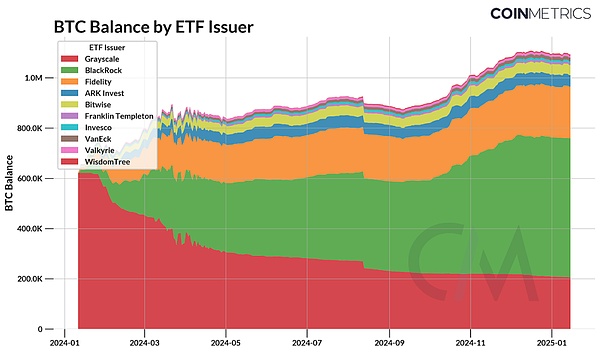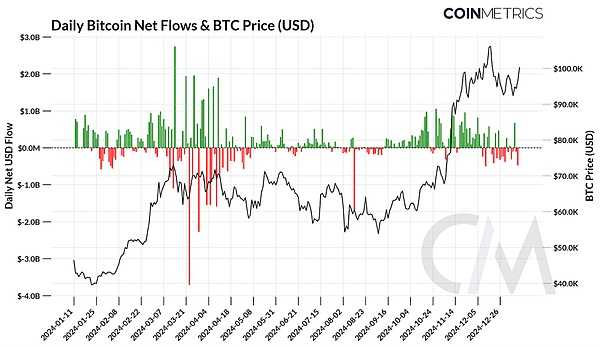Key Points
① The 2024 performance of the Bit Bitcoin Spot ETF: The total assets under management reached $115 billion, currently holding 5.7% of the Bit Bitcoin supply. However, it still only accounts for about 1% of the total assets under management of all global ETFs, indicating that crypto assets still have huge growth potential in the future.
② BlackRock's Bit Bitcoin ETF dominates the market, and as investors turn to low-cost options, Grayscale's once-important position has declined. Overall, Bit Bitcoin Spot ETFs have driven institutional adoption, redefined the market structure, and consolidated Bit Bitcoin's position as a mainstream asset.
③ Trump has promised to turn the US into a "crypto capital" and appointed Sachs as the crypto currency czar. With the advancement of the FIT 21 Act, the proposal of the Bit Bitcoin reserve plan, and the shift in the regulatory attitude, the crypto industry will see a policy spring in 2025.
2024 was an exciting year in crypto history. Bit Bitcoin price hit a new high, blockchain infrastructure was significantly improved, stablecoins found product-market fit, and Bit Bitcoin and ETH spot ETFs were approved. At the same time, the US legislative and regulatory environment is paving a positive way forward for the industry. All of this sets the stage for the continued explosion in 2025.
For the US stock market, the launch of Bit Bitcoin spot ETFs is clearly of great significance. They have expanded the investment channels for retail and institutional investors to invest in Bit Bitcoin, attracting billions of dollars in net capital inflows, and elevating this asset class from a niche asset to a mainstream asset. This may be the most successful ETF in financial history, with its assets under management (AUM) exceeding $110 billion in just one year.
In this article, the RockFlow research team will take you through the remarkable success of the Bit Bitcoin spot ETFs on their first anniversary, review the leading issuers and their profound impact on Bit Bitcoin and the financial markets, and most importantly, why we believe the crypto market will see a new landscape in the Trump 2.0 era.
1. Bit Bitcoin Spot ETFs Launched a Year Ago, Crypto Market Undergoes a Major Transformation
After a decade of anticipation, repeated rejections of applications, and the crypto market being caught off guard by false news, the US Securities and Exchange Commission (SEC) finally approved the launch of Bit Bitcoin spot ETFs on January 10, 2024.
Soon after, 11 ETFs entered the market, competing to attract capital inflows. The issuers include traditional financial giants like BlackRock and Fidelity with trillions of dollars in assets under management, as well as crypto-native institutions like Bitwise.

The Bit Bitcoin spot ETFs were immediately embraced by a flood of capital. The acceleration of capital inflows coincided with a period of high market sentiment, bringing fresh blood to all areas of the crypto ecosystem. Although there was a slump in the summer of 2024, Trump's victory in the US presidential election in November again boosted optimism, and ETF inflows were further strengthened.
To date, the net inflow of Bit Bitcoin spot ETFs is about $32 billion, holding over 1.1 million Bit Bitcoins, equivalent to a total asset size of $115 billion. These holdings currently account for about 5.7% of the circulating Bit Bitcoin supply.
However, Bit Bitcoin spot ETFs only account for about 1% of the total assets under management of all global ETFs, indicating that crypto assets still have huge growth potential in the future.
Who is behind this abundant capital? In fact, Bit Bitcoin spot ETFs are mainly targeted at three groups - individual investors, wealth advisors, and institutional investors. 13F filings have revealed the buyers behind Bit Bitcoin spot ETFs, including both retail and professional investors, as well as hedge funds and financial institutions like Goldman Sachs and Millennium Management. This reflects the growing interest in the financial market to include Bit Bitcoin in investment portfolios, and Bit Bitcoin spot ETFs have served as the perfect bridge between traditional finance and the crypto world.
The RockFlow research team expects capital inflows to accelerate further in 2025, and with the relaxation of regulatory conditions, we will also see broader participation from pension funds, family offices, and endowment funds. Optimistically, the AUM of Bit Bitcoin spot ETFs could double.
2. The ETF Issuers and How They Impact Bit Bitcoin Itself
Previously, Grayscale's GBTC was the main tool for indirect investment in Bit Bitcoin, but after the mass launch of Bit Bitcoin spot ETFs, GBTC has faced challenges due to its high management fees. New investors (and even existing investors) have largely shifted to the newly launched Bit Bitcoin spot ETFs, as their fees are generally around 0.2% (many even started with a 0% fee), much lower than Grayscale's GBTC at 1.5%.
In addition, GBTC is also undergoing changes, actively splitting off another lower-fee Grayscale Bit Bitcoin Mini Trust (BTC) as a low-cost alternative to GBTC.
From the issuer's perspective, BlackRock and Fidelity are clearly the biggest winners. Take BlackRock as an example, its Bit Bitcoin spot ETF - IBIT currently holds about 540,000 Bit Bitcoins, accounting for half of the total Bit Bitcoins held by all ETFs, while Grayscale's GBTC's Bit Bitcoin holdings have plummeted from 600,000 to 200,000, becoming the biggest loser.
On the other hand, BlackRock's IBIT has an asset management scale approaching $60 billion, far exceeding the scale of BlackRock's largest gold ETF - IAU ($35 billion), further consolidating Bit Bitcoin's position as "digital gold". According to Bloomberg ETF analyst statistics, IBIT reached the $50 billion AUM milestone in just 227 trading days, breaking the previous record of 1,323 days set by iShares Core MSCI Emerging Markets ETF (IEMG).
Investors' interest in Bit Bitcoin has led them to support Bit Bitcoin spot ETFs with real money, and at the same time, Bit Bitcoin spot ETFs are also impacting the price and market structure of Bit Bitcoin itself. According to Coin Metrics' analysis, as a stable source of demand for Bit Bitcoin, the net inflow of capital into Bit Bitcoin spot ETFs has had a very significant impact on Bit Bitcoin prices.
The chart shows that large inflows or outflows of capital into Bit Bitcoin spot ETFs almost always coincide with major price fluctuations in Bit Bitcoin.

Especially during periods of strong market momentum or large increases in capital inflows, the correlation between the two tends to strengthen, indicating that as issuers buy Bit Bitcoin to meet ETF investor demand, it has become a structural driver of Bit Bitcoin price appreciation. And with the continued rise in Bit Bitcoin prices, the appeal of ETF products to retail and institutional investors has increased, thus forming a mutually reinforcing feedback loop that attracts more capital inflows.
Of course, it should be noted that the two do not move in perfect sync, as factors beyond just the spot ETFs, such as the broader macroeconomic environment, investor sentiment, and the market impact of institutions like MicroStrategy, also play an important role.
3. In the Trump 2.0 Era, the Crypto Market Will See a New Landscape
The RockFlow research team believes that the crypto market will see further upside in 2025, mainly because the crypto-friendly president - Trump is officially taking office. In the previous year, he had expressed his support for the crypto economy multiple times during his campaign, including but not limited to:
Firing the current SEC chairman Gary Gensler who has repeatedly "harassed" the crypto industry,
Reducing the prison sentence of the Silk Road founder,
Ending the US's suppression and "crackdown" on cryptocurrencies,
Preventing the US from further developing a CBDC,
Making the US the world's "crypto capital",
Preventing the US from selling its Bit Bitcoin holdings,
Establishing a strategic Bit Bitcoin reserve,
Suggesting the use of cryptocurrencies to solve the US debt problem,
Appointing a crypto advisory council and promoting rules "made by those who love the industry", etc.
The newly inaugurated Trump is indeed steadily advancing the commitments he made to the cryptocurrency industry at the time. Therefore, in 2025, the Trump administration and the Republican-controlled Congress may bring about major changes to the cryptocurrency sector - a welcome change for industry participants.
In addition, in the latest US presidential election, the cryptocurrency industry has begun to "show its hand" and has become one of the important financial backers: according to relevant reports, the super political action committee (PAC) Fairshake, which supports cryptocurrencies, has raised more than $200 million from the cryptocurrency industry to help pro-cryptocurrency candidates win. It is mainly aimed at Republican and key Democratic candidates, and this move is expected to continue to bring the much-needed regulatory clarity to the cryptocurrency industry.
It is worth mentioning that as early as December 2024, Trump appointed former PayPal executive Sachs as the White House's "AI and Cryptocurrency Czar". Sachs is seen as a supporter of innovation and the cryptocurrency industry, and some cryptocurrency practitioners believe that this "Cryptocurrency Czar" is likely to bring more positive news in support of digital assets.
Furthermore, during the previous Congress, the US House of Representatives passed the 21st Century Financial Innovation and Technology Act (FIT 21), which aims to establish a regulatory framework for digital assets and allocate jurisdiction between the SEC and the Commodity Futures Trading Commission (CFTC). Although FIT 21 did not meet all the demands of the cryptocurrency industry, it represents the greatest effort made by the US Congress to date.
Additionally, interest in establishing a BTC strategic reserve has been rekindled. Republican Senator Cynthia Lummis of Wyoming recently introduced the BTC Act, which aims to establish a strategic BTC reserve for the US and develop a structured BTC purchasing plan.
In addition to the above, the RockFlow research team expects that the US Federal Reserve and other financial regulators will revisit the cryptocurrency policies of the Biden era. Since 2021, regulators have put pressure on banks through the issuance of various relevant interpretations, requiring them to "discontinue" controversial cryptocurrency businesses, essentially preventing banks from engaging in custody and other activities. Given that Trump has promised to protect the cryptocurrency industry from regulatory "persecution", the revocation of these interpretations means a significant shift in regulation.
Finally, the increase in capital market activity in the cryptocurrency industry is also an important positive factor. Accompanied by increased regulatory transparency, as well as factors such as continued investor attention, increased institutional adoption, and increased venture capital, related capital market activities (including IPOs) are expected to increase significantly. As the cryptocurrency economy matures, the integration of regulatory development and market enthusiasm will create more opportunities for public listings, mergers and acquisitions, and deeper institutional participation.
Conclusion
The RockFlow research team believes that financial products represented by the BTC spot ETF are reshaping the cryptocurrency investment landscape. They not only effectively attract the inflow of institutional and retail funds, but also drive the structural demand for BTC. Over the past year, they have proven their potential for legitimization and expansion of the use cases of cryptocurrency assets.
At the same time, while the ETH ETF has gotten off to a slower start, its development momentum is gradually emerging, and investor demand for it is growing. As the market matures further, new opportunities may further increase the attractiveness of the cryptocurrency market to traditional financial investors. The next wave of ETF inflows may unleash even greater growth.
In 2025, with the expectation of a crypto-friendly policy, a clearer regulatory environment, continued institutional investor participation, and strategic reserve plans, the cryptocurrency market will usher in a new round of growth cycle.





